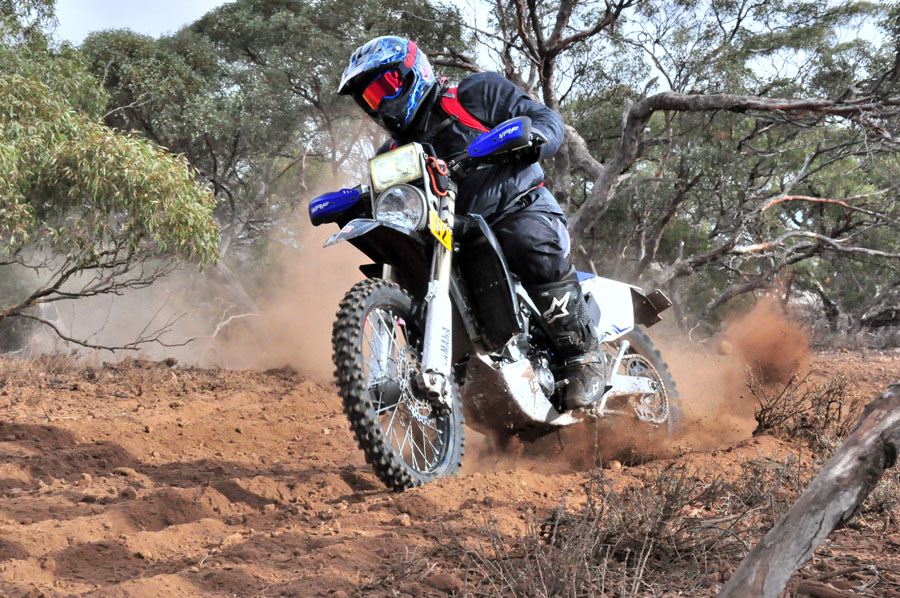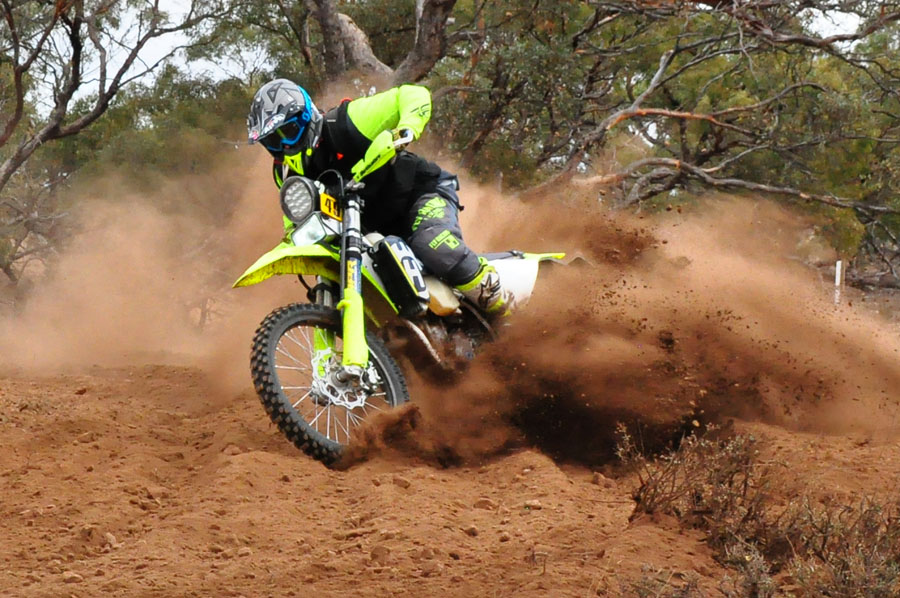MACHINES.
All machines will comply with the MA Manual of Motorcycle Sport, South Australian Reliability Trials Supplementary Rule Book, Road Traffic Act and A.D.R’s. Road traffic permits are acceptable.
Sidecar machines will also comply with SIDECAR REQUIREMENTS.
A competitor throughout the trial will use only one machine. Sidecar machines will be driven by the nominated rider, and will carry the nominated passenger throughout the trial.
REAR VIEW MlRRORS.
TWO (2) of 50mm diameter (minimum) required per machine and must be mounted on the handlebars in the fully extended position (not folded) when presented to machine examination. The mirror glass must not be restricted by tape or any other obstacles that would impair the rider’s vision.
HANDLEBARS.
As per MA Manual of Motorcycle Sport, The handle bars must be equipped with a protection pad on the cross bar. Handle bars without a cross member must be equipped with a protection pad located in the middle of the handlebars, covering the handlebar clamps.
All handlebar ends to be securely plugged; not just blanked off.
SIDECAR Lanyard cut out switch must be fitted and operational as per GCR’s, the lanyard must be tethered to the rider whilst machine is being ridden.
COMPETITOR NUMBER.
 For the purpose of attaching the competitors RIDING NUMBER (supplied by the organisers) at machine examination, each solo competitor shall supply a MOUNTING PLATE fixed to their machine in an unobstructed position on the left front side above the lower triple clamps.
For the purpose of attaching the competitors RIDING NUMBER (supplied by the organisers) at machine examination, each solo competitor shall supply a MOUNTING PLATE fixed to their machine in an unobstructed position on the left front side above the lower triple clamps.
Each sidecar team shall supply a MOUNTING PLATE fixed to their machine prominently on the left front corner of the sidecar body.
The MOUNTING PLATEmay be fabricated from metal, aluminium, or a durable plastic, of no less than 115mm x 90mm, and must be able to accept either of the numbers provided by the organisers.
A mounting bolt of 6mm in diameter shall be fixed to the plate for the purpose of attaching the metal, aluminium, or durable plastic number provided by the event organisers.
Failure to supply the MOUNTING PLATE will incur a 300 point penalty.
Adhesive numbers may be provided by the organizers, as an addition or substitution to metal, aluminium or plastic numbers.
REGISTRATION PLATE
All registered machines must be fitted with a registration plate as issued by the motor registration division. All machines issued with permits must be fitted with a plate in similar position to where a registration plate would be mounted. The plate may be fabricated from metal, aluminium or durable plastic and shall be 215mm wide x 95mm high. FAILURE TO COMPLY WILL INCUR A PENALTY OF 30 POINTS.
TYRES.
SOLO &SIDECAR a tyre isNOT PERMITTEDto be used with the words “NOT FOR HIGHWAY USE” or similar type wording on the tyre. Some events may impose further restrictions. TYRES NOT TO BE MODIFIED.
HORN.
A warning device must be fitted and operational, the device must be continuous and audible to other road users.
LIGHTS.
Headlights (Maximum 2), with operational effective high and low beams minimum 25 watts must be fitted to the Motorcycle only.
Where a combination of headlights are fitted (Maximum 2), Halogen or High-Intensity Discharge (HID) is acceptable for either headlight. At least one headlight must contain the high beam, and an effective short-range low beam behind the one lens. Light Emitting Diode (LED) lights will be accepted only for the auxiliary driving second headlight. Only one auxiliary light is allowed along with the main light, and any amount of individual LED’s can be used in the LED array, as long as they are in the one housing.
If two headlights are fitted and only one of the two headlights has the low beam, the second light is considered to be an auxiliary light, and therefore must be simultaneously switched off by means of the main headlight high/low-beam switch only, when lights are dipped to low-beam.
High-Beam or auxiliary light maybe isolated by a separate switch, but the high-beam or driving light must not be operating when lights are switched to low-beam, and must be simultaneously switched off by means of the main headlight high/low-beam switch only, when lights are dipped to low-beam. Taillight and sidecar clearance light must be operating at all times when the headlight/s are on.
Tail lights for sidecars – two (2) red ones required.
One lamp will be on the centre line of the motorcycle, the other lamp will be fitted to the left side rear.
All machines are required to have a separate rear reflector, RED in colour. The dimensions shall not be less than 50mm round, or 25mm x 60mm rectangle. The Reflector must not obstruct any part of the registration plate.
Two reflectors, one either side, are required for sidecars. Reflective tape is not acceptable.
STOP SIGNS.
 WHITE BACKGROUND with a DIAGONAL RED CROSS means all competitors are required to stop before proceeding. A caution sign may be displayed within thirty (30) metres before the stop sign in a competitive section.
WHITE BACKGROUND with a DIAGONAL RED CROSS means all competitors are required to stop before proceeding. A caution sign may be displayed within thirty (30) metres before the stop sign in a competitive section.
Forward motion will completely cease and one foot will be placed on the ground by the SOLO or SIDECAR RIDER, this also applies to RTA (Road Transport Authority) stop signs.
Subject to SECTION b), If clear vision of the road being entered is obstructed at the location of a stop sign which has been placed by the event organisers, the rider must stop at the stop sign, complete the stop procedure, before continuing on to a more suitable location where they have a clear vision to enter the road safely.
FAILING TO STOP may incur exclusion or the minimum PENALTY OF SIX HUNDRED (600) points.
THE ROUTE.
Competitors will follow the correct course as laid down by the Organising Club or Committee. It is recommended the distance between designated fuel stops not to exceed 80km. If the distance is greater than the recommendation, the promoting Club or Organising Committee is advised to notify competitors before the start of the event.
THE COURSE WILL BE MARKED AS FOLLOWS:
STRAIGHT ON – WHITE MARKERS, or other markers approved by the Reliability Trials Sports Manager.
DIRECTIONAL – WHITE BACKGROUND with RED ARROWS, or other markers approved by the Reliability Trials Committee. Placement is recommended 10 metres minimum before a corner, as well as two being placed on the corner. A course indication marker should then be placed a short distance after a change of direction.
STOP – WHITE BACKGROUND with a DIAGONAL RED CROSS, (refer to section STOP SIGNS).
BUNTING – May also be used to accurately define course.
SECTION ALTERED – To be used at controls, in conjunction with a CAUTION SIGN, where a competitive section has been altered for safety or land management reasons.
CAUTION – WHITE BACKGROUND with RED EXCLAMATION MARK in RED TRIANGLE
 The caution sign shall take the shape of an EQUILATERAL TRIANGLE, (fig1) the length of each side being no less than 400mm long. within the triangle there is to be placed a RED EQUILATERAL TRIANGLE of 25mm thickness, the length of each side being no less than 300mm long. In the centre of this red triangle there will be placed a RED EXCLAMATION MARK of no less than 150mm in length and drawn in proportion to its surrounds. The caution sign will be placed at least 30 metres before the danger.
The caution sign shall take the shape of an EQUILATERAL TRIANGLE, (fig1) the length of each side being no less than 400mm long. within the triangle there is to be placed a RED EQUILATERAL TRIANGLE of 25mm thickness, the length of each side being no less than 300mm long. In the centre of this red triangle there will be placed a RED EXCLAMATION MARK of no less than 150mm in length and drawn in proportion to its surrounds. The caution sign will be placed at least 30 metres before the danger.
START – THE WORD “START” INSIDE GREEN CIRCLE within YELLOW BACKGROUND
The “START” Signs shall be placed at the start of a competitive section to visually acknowledge the point at which timing has started. Two (2) START signs will be placed on the left and right of the marked course guiding the competitors to ride between. The competitors start time begins as the competitor passes the signs.
DIMENSIONS: The signs shall be square in shape and no less than 400mm x 400mm.
END – THE WORD “END” INSIDE ORANGE CIRCLE within YELLOW BACKGROUND
 The “END” signs shall be placed for the competitor to visually acknowledge the finish of the competitive timed section.
The “END” signs shall be placed for the competitor to visually acknowledge the finish of the competitive timed section.
Two (2) END signs will be placed on the left and right of the marked course at the finish of each timed section, guiding the competitors to ride between. The competitors finishing time will be taken at the exact second the competitor passes the signs. DIMENSIONS: The signs shall be square in shape and no less than 400mm X 400mm.
In all private property sections competitors are required to ride BETWEEN THE MARKERS, as erected by the Organising Club or Committee. Where only single course markers are used riders will ride within three (3) metres of each marker. Failure to follow the course will INCUR A PENALTY OF SIX HUNDRED (600) POINTS or MAY INCUR EXCLUSION
- Where 2 markers are used the minimum width between the markers shall be 1.7 metres.
- Any damage caused to public or private property will be reported as soon as possible to the nearest control official and the Organising Club or Committee at Main Control. Should a competitor leave the course at any point, the competitor WILL RETURN TO THAT POINT before continuing along course as marked.
- Competitors are advised of the dangers of travelling the course in the reverse direction in a competitive section at any time during the running of the Trial. Any competitor observed doing so in an attempt to book into a Route Check Point will BE EXCLUDED from the event.
Where the course involves riding on a sealed road, competitors will remain on the sealed portion of the road at all times. Any competitor failing to do so may incur exclusion, or a minimum PENALTY OF 600 POINTS. (Refer to section 12 compliance with road laws).
If changes to the course are necessary during a Trial, then those changes will be marked with discs and arrows at the discretion of the Organising Club or Committee.















































